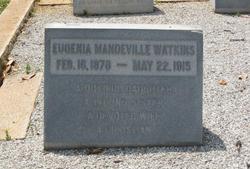Author: Jamie Bynum
The large, currently yellow and purple, Victorian-style historic home that stands in Carrollton, Georgia is known as the Mandeville Mansion or the Maple Street Mansion. This home was built around 1890 for the family of Leroy Clifton Mandeville, who was born in 1851. He and his wife, Carrie Richardson Mandeville, had five children: Leroy Clifton Jr., Eleanor, Eugenia, John, and Camilla. If you already know about Carrollton’s textile industry, the Mandeville name will be familiar to you: Mandeville Cotton Mills was arguably the most prominent textile mill within the Carrollton city boundaries. It was organized by Joseph Aycock, Henry Lovvorn, and Leroy Clifton Mandeville in 1902 as the combination of Carrollton Oil Mill and Mandeville Cotton Mill. As for the name of the street, it is said that Leroy’s father, Appleton Mandeville, planted maple trees for his wife from Vermont on the lot before the mansion was constructed. This house was the first in the area to have indoor plumbing and electricity.

This location served as a home until its conversion to commercial use in the 1960s. One of the most notable names from this building was the restaurant known as The Maple Street Mansion which catered to both Carrollton residents and students from the University of West Georgia. During its commercial usage, the house was expanded to include an event space, meeting room, and a sports bar inside of a 19th-century train car. In March of 2014, Mandeville Mansion was in danger of being torn down. Though the house had been purchased by a private individual in an attempt to save it, renovation funds were lacking and the owner feared that, without a thorough rehabilitation, the historic home would have to be razed. Many citizens of Carrollton were invested in trying to keep the mansion as a tangible part of Carrollton’s history and began raising money for the necessary renovations on the 123-year-old mansion. Since then, it has served as a few different restaurants, the most recent being 4 am Coffee Roasters Cafe and Bar.

With the popularity of the building, rumors have spread about its potential “resident ghost”. Eugenia, one of the daughters of Leroy and Carrie Mandeville, is rumored to have lept from a third-story window at the age of 18 and many claim she still roams the halls of the building. Her headstone in the Carrollton City Cemetery tells a different story: it puts her birth in 1878 and her death in 1915, meaning she would have been 37 years old at the time of her death.

The Mandeville Mansion, the Maple Street Mansion, or “the large purple and yellow building” has been in Carrollton for over 130 years and is beloved by the residents of the community. It has a long history of initially serving the family of a textile mogul, then all of the citizens of Carrollton.



